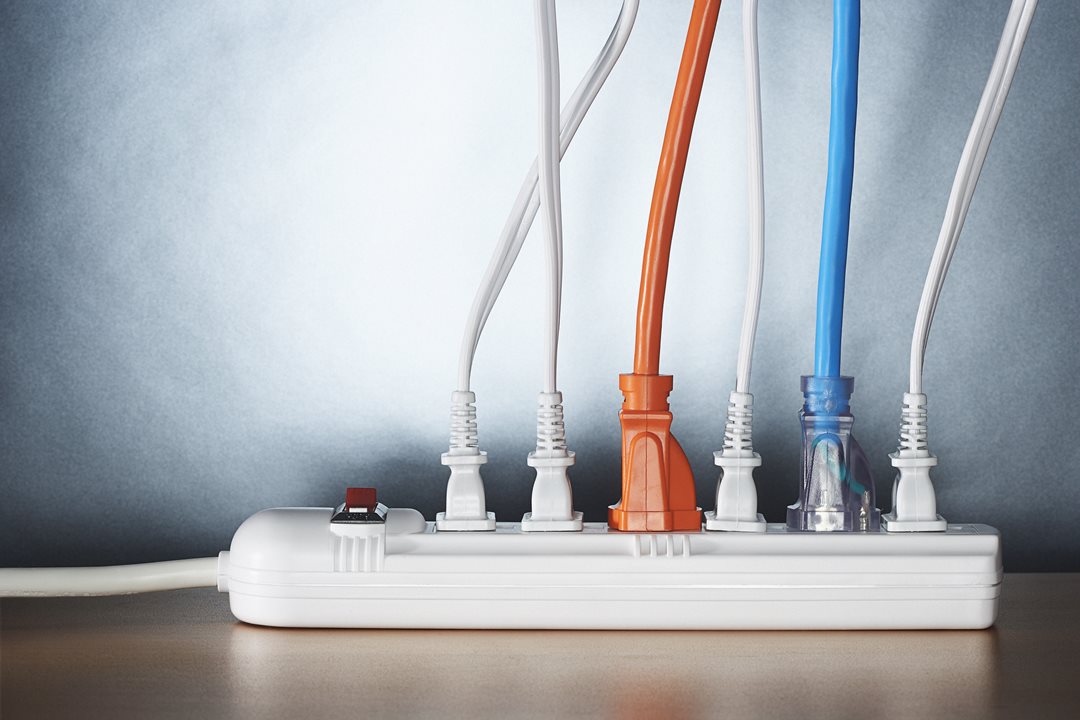Is your surge protector several years old? Time to replace it I PEMCO
 Surge protectors don’t last forever, and using one past its prime isn’t just a risk to your electronics; it can also be a fire hazard. Most experts say that good surge protectors last two to five years. If the surge protector you’re using for devices like your computer, TV, holiday decor, or programmable appliances is older than that, it’s time to replace it.
Surge protectors don’t last forever, and using one past its prime isn’t just a risk to your electronics; it can also be a fire hazard. Most experts say that good surge protectors last two to five years. If the surge protector you’re using for devices like your computer, TV, holiday decor, or programmable appliances is older than that, it’s time to replace it.
That’s because surge protectors silently absorb hits from every power surge. Over time, their protective components degrade, leaving them less able to handle future surges. A worn-out surge protector can overheat, spark, or fail completely, potentially igniting nearby materials.
Utilities experts suggest two years as the safest replacement interval for most protectors, with five years being the absolute longest interval. If your neighborhood experiences a major power event (like lightning striking a transformer), replace your surge protectors immediately. That surge may have wiped out most of their protective capacity, leaving you vulnerable not only to device damage but also to electrical fire risk.
When should you use a surge protector?
More devices than you might think require a surge protector. Power surges can enter homes not only through electrical lines but also through cable, satellite, and even landline telephone connections. Protect devices such as:
- Cable and satellite TV boxes
- Computer and home office equipment
- Programmable appliances
- Home security systems
Higher-end surge protectors may also include USB ports, coaxial outlets, and Ethernet jacks, which are helpful for safeguarding modern electronics.
Is a power strip the same as a surge protector?
Not necessarily. A power strip may simply provide extra outlets without any protective features. While many surge protectors look like power strips, not all strips are surge-protected.
Here’s how to tell:
- Indicator lights: Look for green lights marked “grounded” and “protected.” If they’re off, your surge protector may no longer be safe.
- Protection wording: Check the strip for terms like “suppression” or “protection,” or packaging references to “joule energy ratings.”
Extra tip: Some experts recommend writing the month and year that you replaced your surge protector(s) directly on the device using a permanent marker. It will take the guesswork out of when it’s due for a replacement!
Home safety starts with prevention
Electrical fires are one of the leading causes of home damage, and many start with outdated or overloaded equipment. To reduce risk:
- Replace surge protectors every few years or after a major power event.
- Unplug sensitive electronics during storms as part of your windstorm preparedness plan.
- Avoid overloading outlets—spread devices across circuits.
- Inspect cords and plugs regularly for fraying or heat damage.
Safety reminder: Don’t daisy-chain your power strips or surge protectors together. This can overload circuits and significantly increase fire risk.
Take extra precautions over the holidays
Between decorative lights, extension cords, and extra appliances running at once, December is one of the busiest times for household circuits. To keep celebrations safe:
- Avoid overloading outlets: Plugging too many lights or appliances into one surge protector or outlet increases fire risk. Spread devices across multiple circuits.
- Use surge protectors for decorations: Holiday lights and inflatables are vulnerable to power surges, especially during winter storms. A surge protector helps prevent overheating and electrical fires.
- Turn off decorations before bed or leaving home: Unattended lights and powered décor are a common source of holiday fires.
- Choose UL-listed products: Look for safety certification labels on lights, surge protectors, and extension cords to ensure they meet fire safety standards.
Does PEMCO cover power surges?
Your homeowners or renter policy covers many perils, including lightning, that cause electronics-damaging power surges. Keep in mind: losses are subject to your deductible and may affect your claim-free discount.
Prevention first: protect your home and peace of mind
Outdated surge protectors don’t just put your electronics at risk, they can become a hidden source of electrical fires. By replacing surge protectors at a regular cadence or immediately after a major power event, you’re taking a simple step that safeguards your home, your personal possessions, and your family’s peace of mind. It’s a small investment in safety that pays off in confidence, knowing your home is better prepared for the unexpected.
Share on social media